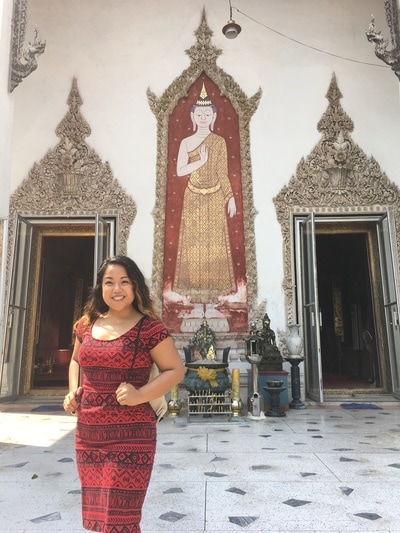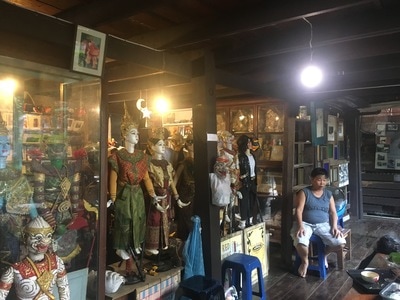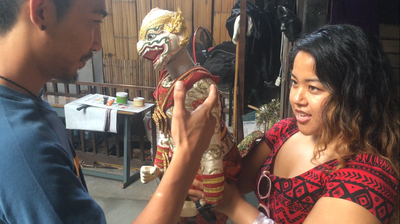THE JOURNEY
It is my third week living in Bangkok and I can confidently say "I live here." I have my studio apartment outside 20 minutes from the city center, Thai cell number, my favorite cafe, my fruit stand, and my theater community. It was time to travel outside the city to an artist community holding on to their home and theatrical traditions at Baan Silapin Artists House in the Klong Bang Luang Artist Village.
It takes about 1 hour to get there from Central Bangkok, and another 15 minutes by taxi. May, a freelance writer and translator who grew up in this part of town was delighted to show me around her neighborhood. As we started our way up the walking bridge hovering over the peaceful canal, I could feel myself breathing deeper and relaxing into a quiet village life. I could get used to this. Thonburi charmed me with its small tin roof huts, and smiling locals. Luck for us, it was National Children's Day, where towns offer free events for kids around the country. Right in front of the main temple, there was a sort of game show hosted by a Buddhist monk that defied all expectations. A monk/comedian/gameshow host awarded gift baskets to the brave children who could take his Q & A (and teasing).
It is my third week living in Bangkok and I can confidently say "I live here." I have my studio apartment outside 20 minutes from the city center, Thai cell number, my favorite cafe, my fruit stand, and my theater community. It was time to travel outside the city to an artist community holding on to their home and theatrical traditions at Baan Silapin Artists House in the Klong Bang Luang Artist Village.
It takes about 1 hour to get there from Central Bangkok, and another 15 minutes by taxi. May, a freelance writer and translator who grew up in this part of town was delighted to show me around her neighborhood. As we started our way up the walking bridge hovering over the peaceful canal, I could feel myself breathing deeper and relaxing into a quiet village life. I could get used to this. Thonburi charmed me with its small tin roof huts, and smiling locals. Luck for us, it was National Children's Day, where towns offer free events for kids around the country. Right in front of the main temple, there was a sort of game show hosted by a Buddhist monk that defied all expectations. A monk/comedian/gameshow host awarded gift baskets to the brave children who could take his Q & A (and teasing).
THE NEIGHBORHOOD
She took me into the local wat (or temple) called Wat Kamphaeng where we admired the beautiful paintings barely surviving from the towns floods. May explained the the stories in the paintings: Westerners trading with the East, good and evil, and even silly dirty humor between the sexes. Like other temples, this one had the shiny goldleaf painted buddha dressed in his winter garment, and detailed decor from ceiling to floor. At a smaller prayer house outside of the temple, May gave me the unique opportunity to take a sort of fortune. In a can, there were about 30 numbered sticks. I prayed for something good fortune, then I shook the can until one stick fell out. It was 13. I took a the sheet with the same number read, "Wait and see. Good lucks approaching. Love not being satisfied in immediate future." This fortune gave me hope. What is next for me on this adventure? I continued to ponder this fortune over the best noodle soup I've had in Bangkok. This noodle man is also a carpenter who happens to make the best soup in town. Not seen: three loyal feline guardians at his feet.
She took me into the local wat (or temple) called Wat Kamphaeng where we admired the beautiful paintings barely surviving from the towns floods. May explained the the stories in the paintings: Westerners trading with the East, good and evil, and even silly dirty humor between the sexes. Like other temples, this one had the shiny goldleaf painted buddha dressed in his winter garment, and detailed decor from ceiling to floor. At a smaller prayer house outside of the temple, May gave me the unique opportunity to take a sort of fortune. In a can, there were about 30 numbered sticks. I prayed for something good fortune, then I shook the can until one stick fell out. It was 13. I took a the sheet with the same number read, "Wait and see. Good lucks approaching. Love not being satisfied in immediate future." This fortune gave me hope. What is next for me on this adventure? I continued to ponder this fortune over the best noodle soup I've had in Bangkok. This noodle man is also a carpenter who happens to make the best soup in town. Not seen: three loyal feline guardians at his feet.
THE HOME
Getting to Baan Silapian Artists House is an adventure. It’s not easily accessible, but that is what makes it so unique. It is not commercial or popularize in any way, there are no signs or lit up billboard. It is a home lived in by theater artists who give free shows to the community daily. This style of Kohn puppets is an original Thai puppetry form developed from Kohn dance dramas. There is a brother company Joe Luis Puppet Theater use the same form but as more of a dinner theater performance in Bangkok. When the original troupe split a decade ago, these artists decided to preserve the tradition and keep it in the community.
A member of Kum Nai Thai Puppet Theater Company maintains this property with its surrounding community. The house itself was granted to one of the company members as gift from the princess. We were standing in a preserved landmark of the city. The atmosphere is charmingly mom and pop, they keep this place running with a unique gift shop, mask painting corner, and a delicious coffee shop. There are just a few pews for the audience, but the best seats in the house were on the floor up front. On the second floor, was balcony seating above and three artist spaces. The first held a shrine to the grandfather of the arts and the other had Ganesha, the god of knowledge and the arts. We pay our respects to both before entering the space.
Getting to Baan Silapian Artists House is an adventure. It’s not easily accessible, but that is what makes it so unique. It is not commercial or popularize in any way, there are no signs or lit up billboard. It is a home lived in by theater artists who give free shows to the community daily. This style of Kohn puppets is an original Thai puppetry form developed from Kohn dance dramas. There is a brother company Joe Luis Puppet Theater use the same form but as more of a dinner theater performance in Bangkok. When the original troupe split a decade ago, these artists decided to preserve the tradition and keep it in the community.
A member of Kum Nai Thai Puppet Theater Company maintains this property with its surrounding community. The house itself was granted to one of the company members as gift from the princess. We were standing in a preserved landmark of the city. The atmosphere is charmingly mom and pop, they keep this place running with a unique gift shop, mask painting corner, and a delicious coffee shop. There are just a few pews for the audience, but the best seats in the house were on the floor up front. On the second floor, was balcony seating above and three artist spaces. The first held a shrine to the grandfather of the arts and the other had Ganesha, the god of knowledge and the arts. We pay our respects to both before entering the space.
THE COMPANY
In speaking with company members of the Kum Nai Thai Puppet Company, I learned that training is at least 9 years. From a young age, you engage in rigorous physical and historical training. It involves a mix between posture, strength training, and studying the stories of the Ramayana. He told me about the pain he felt as a young boy pounding and stomping on cement floors. They have endured a lot of injuries over the years, but they admitted that he would never stop a performance. "The show must always go on," he stated passionately.
Similar to other mask performance like Commedia dell'arte and Noh, a performer learns one type of character and that is who they will be for the rest of their life. When you reach the age of 13, after you have completed years of training, your master will assess your skills and personality and give you your character. The characters are divided into 4 basic parts: the male, the female, the monkey and the giant. The male and female require the basic skills. The monkey requires speed and gymnastic movement, while the giant is bigger and stronger. The company member here is the monkey (Hanuman). He enjoys this character because he is able to push himself further and further adding more tricks.
There is no director in this company. I repeat, they do not have a director! They all know the stories, since it was part of their years of training, so they work together to craft the performance based on the chosen story. They have a business managers and a small technical crew, but the performers are in charge of the artistic side of the work. It takes a minimum of 9 years to study Kohn mask and dance, and then another 2 years studying this Kohn puppetry.
In speaking with company members of the Kum Nai Thai Puppet Company, I learned that training is at least 9 years. From a young age, you engage in rigorous physical and historical training. It involves a mix between posture, strength training, and studying the stories of the Ramayana. He told me about the pain he felt as a young boy pounding and stomping on cement floors. They have endured a lot of injuries over the years, but they admitted that he would never stop a performance. "The show must always go on," he stated passionately.
Similar to other mask performance like Commedia dell'arte and Noh, a performer learns one type of character and that is who they will be for the rest of their life. When you reach the age of 13, after you have completed years of training, your master will assess your skills and personality and give you your character. The characters are divided into 4 basic parts: the male, the female, the monkey and the giant. The male and female require the basic skills. The monkey requires speed and gymnastic movement, while the giant is bigger and stronger. The company member here is the monkey (Hanuman). He enjoys this character because he is able to push himself further and further adding more tricks.
There is no director in this company. I repeat, they do not have a director! They all know the stories, since it was part of their years of training, so they work together to craft the performance based on the chosen story. They have a business managers and a small technical crew, but the performers are in charge of the artistic side of the work. It takes a minimum of 9 years to study Kohn mask and dance, and then another 2 years studying this Kohn puppetry.
THE PERFORMANCE
I sat in the front row surrounded by children ages 3-6, which is the best seat in the house. A puppeteer and jolly host introduced the performance giving a brief history of the space, the company, and the story we are about to see. He asks Thai people to kindly help their English speaking friends, because he only speaks Thai. Before they began, they brought out the puppets performing, along with two portraits of the late King Bhumibol Adulyadej. This is customary for all performances and film in Thailand. We all stood while the performers bow to give their respect. The puppets stand beside the portraits like loyal guardians. The are treated and respected as equal company members.
This short performance had three parts. Hanuman is introduced and sets out to capture the mermaid. She manages to lose him in the crowd and the company uses this chase as a time to take donations from the audience. The puppets are able to grab the paper money with both hands. Offer kisses and hugs. The sneaky, and silly Hanuman went as far as to grab an audience member’s bad and camera and placed it in a donation box. The mermaid flirted with a little boy who was too shy to give her a hug. When the audience interaction segment ended. The Mermaid rested peacefully onstage, thinking she had lost the Hanuman. He finds her and they engage in a battle. The battle becomes a flirtation and they fall in love. A sweet ending to this short episode of what I know to be a long saga of the Ramayana.
Notice how their feet move with precision, flexing and stomping. Their knees are always bent, which creates smooth movement and more freedom to move their legs quickly. There are three puppeteers per puppet: right controls the right arm, the center controls the feet, and the left controls the left arm and head. The trio moves swiftly like one body held together by the puppet. They wear a black neutral mask with the face of the buddha, with a peaceful smile. Here is a 90 second video featuring performance highlights:
I sat in the front row surrounded by children ages 3-6, which is the best seat in the house. A puppeteer and jolly host introduced the performance giving a brief history of the space, the company, and the story we are about to see. He asks Thai people to kindly help their English speaking friends, because he only speaks Thai. Before they began, they brought out the puppets performing, along with two portraits of the late King Bhumibol Adulyadej. This is customary for all performances and film in Thailand. We all stood while the performers bow to give their respect. The puppets stand beside the portraits like loyal guardians. The are treated and respected as equal company members.
This short performance had three parts. Hanuman is introduced and sets out to capture the mermaid. She manages to lose him in the crowd and the company uses this chase as a time to take donations from the audience. The puppets are able to grab the paper money with both hands. Offer kisses and hugs. The sneaky, and silly Hanuman went as far as to grab an audience member’s bad and camera and placed it in a donation box. The mermaid flirted with a little boy who was too shy to give her a hug. When the audience interaction segment ended. The Mermaid rested peacefully onstage, thinking she had lost the Hanuman. He finds her and they engage in a battle. The battle becomes a flirtation and they fall in love. A sweet ending to this short episode of what I know to be a long saga of the Ramayana.
Notice how their feet move with precision, flexing and stomping. Their knees are always bent, which creates smooth movement and more freedom to move their legs quickly. There are three puppeteers per puppet: right controls the right arm, the center controls the feet, and the left controls the left arm and head. The trio moves swiftly like one body held together by the puppet. They wear a black neutral mask with the face of the buddha, with a peaceful smile. Here is a 90 second video featuring performance highlights:
THE LESSON
Following the performance, I had the unique opportunity to have a private lesson with a member of the Kum Nai Thai Puppet Company. He explained that all control happens with my right index finger and thumb. I must be able to carry the entire puppet between these two fingers. This puppet was 7 lbs., and others can be up to 15 lbs. Now it was my turn! I consider myself pretty strong for a 4'10 woman, but the muscles between my fingers are not. My forearm started to cramp just 5 minutes of propping it up. This is something that took him over a decade to perfect, I wasn’t about to get it in 15 minutes. I kept trying until both my master, and the puppet was satisfied!
For this quality of work, the performances are surprisingly free and happen almost every day of the year at 2pm. The only days they don’t perform, are on holidays and when they have the opportunity to perform for private events. For each performance, they divide the donations equally. Most days they have enough to eat for the day and turn the lights on. And others, they hope to pocket some money home. In this company, it is understood that they take care and repair the puppets themselves.
As we said our final goodbyes, I found myself emotional hugging him and the hanuman. They invited me to come back next month to see another different performance. I thanked him and his company for taking the time to share their work with me so intimately. He looked me in the eyes as May translated, "I can tell that you really care about this in your heart. This is why I want to share."
Following the performance, I had the unique opportunity to have a private lesson with a member of the Kum Nai Thai Puppet Company. He explained that all control happens with my right index finger and thumb. I must be able to carry the entire puppet between these two fingers. This puppet was 7 lbs., and others can be up to 15 lbs. Now it was my turn! I consider myself pretty strong for a 4'10 woman, but the muscles between my fingers are not. My forearm started to cramp just 5 minutes of propping it up. This is something that took him over a decade to perfect, I wasn’t about to get it in 15 minutes. I kept trying until both my master, and the puppet was satisfied!
For this quality of work, the performances are surprisingly free and happen almost every day of the year at 2pm. The only days they don’t perform, are on holidays and when they have the opportunity to perform for private events. For each performance, they divide the donations equally. Most days they have enough to eat for the day and turn the lights on. And others, they hope to pocket some money home. In this company, it is understood that they take care and repair the puppets themselves.
As we said our final goodbyes, I found myself emotional hugging him and the hanuman. They invited me to come back next month to see another different performance. I thanked him and his company for taking the time to share their work with me so intimately. He looked me in the eyes as May translated, "I can tell that you really care about this in your heart. This is why I want to share."
FOR YOUR INFO...
- To get there, take the BTS Skytrain to Wongwian Yai stop. Tell the taxi to take you to Artist House.
- All performances are FREE, so tip generously.
- Performance occur daily at 2pm, but call in advance just in case they booked a private event that day. Telephone: 02 868 5279
- They offer 1 hour long khlong boat rides along the river for about 500 Baht. Ask for more information at the cafe!























 RSS Feed
RSS Feed